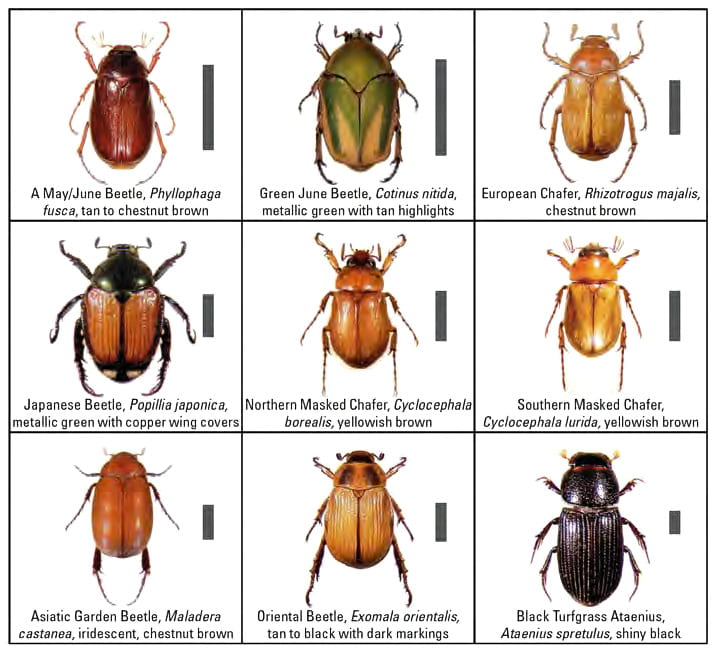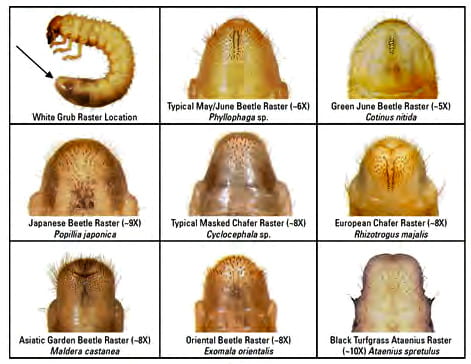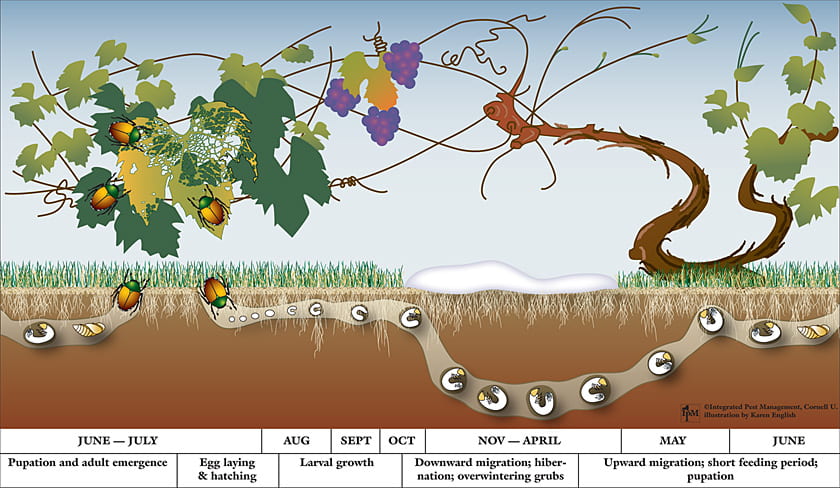Insects may become a problem on your fields. Use the resource Turfgrass Problems: Picture Clues and Management Options to learn about the appearance of the damage, identifying characteristics of different insects, pest information and most importantly damage thresholds and management strategies. Learn how to conduct on site diagnostic procedures to determine the degree of infestation which will determine your course of action.
The latest insect management information can be found in the Cornell Guide for Commercial Turfgrass Management covering the most common turf insect pests and allowable insecticides for NYS.
White grubs probably cause the most damage to turf so managers should learn all about them starting with the introductory information that follows.
White Grubs
The Cornell Grub ID website will help you identify common grub species.
White grubs are the immature stages of scarab beetles, for example, European chafers, Japanese beetles and Oriental beetles.


Although most grubs cause similar damage the treatment needs to correspond to the specific grub. Managers should learn how to identify them by their raster patterns (right, image courtesy The Ohio State University) and their life cycle so possible problems can be anticipated and scouting can take place to determine if and when action will be necessary.
The typical life cycle of annual white grubs (below) includes the following: in late June and early July adults emerge from the ground and begin to search for food and mates. In July, female beetles spend 2-3 weeks laying up to 60 eggs in the soil. Depending on soil moisture and temperature, eggs hatch about 2 weeks later. These first stage (called “first instar”) grubs feed on grass roots for most of August. The grubs are small, feed close to the soil surface and are vulnerable to biological and chemical insecticides at this time. First instar larvae can be difficult to scout for because of their small size, however, controlling larvae at this stage can help to minimize noticieable turf damage later in the season.

From Late August through October (depending on the climate) grubs molt into a second and then third stage. As they grow, grubs consume more roots and damaged turf becomes apparent. As temperatures drop in autumn, grubs move deeper in the soil profile where they overwinter as the third-instar grubs below the frost line.
In the spring, they move up in the soil to feed on roots for a very short time. In late spring, grubs stop feeding and turn into pupae that are resistant to insecticides. In late June or early July, beetles emerge from the pupae and crawl out of the soil completing their life cycle.
Cultural management
Sample first
Sample for grubs in the summer using the techniques outlined in Turfgrass Problems: Picture Clues and Management Options. Make sure you have identified the specific grub and the number found exceeds the threshold.
Maintain a healthy, dense turf by
- Fertilizing and watering properly
- Overseeding and reseeding
- Using Milorganite as a vertebrate deterrent
Consider trying an aeration method tested by Dr. Ben McGraw, of the State University of New York (SUNY) at Delhi. In this study 3/8” and ½” diameter tines were spaced at 1½”, 2” and 3”. Results showed Mortality increases as tine diameter increases and with tighter spacing Mortality increases with multiple passes (up to 90 % control with 2- 4 passes) No difference between solid and hollow tines
Treatment Options
Alternative methods:
A discussion on biological control of white grubs can be found in the Cornell Guide for Commercial Turfgrass Management and in the Maine Yardscaping publication: Using Beneficial Nematodes for Grub Control
Chemical options:
Spring treatments are a waste of time and money since the damage observed is a result of last fall’s activity. Also overwintered, 3rd instar grubs are fairly resistant to insecticides at this time.
If the threshold exceeds 5-7/sq. ft. for European chafers, 8-10/ sq. ft. for Japanese beetles or 5-7/sq. ft. for Oriental beetles curative treatment in late summer or early fall, when the grubs are most susceptible, can be made. Be sure to treat only those areas that exceed thresholds, a blanket application to the entire field is not recommended.


